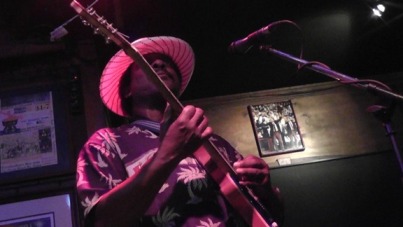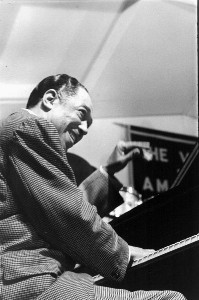On July 7, 1956, Duke Ellington’s most famous live performance, and one of the most legendary in all of jazz, occurred at the Newport Jazz Festival in Rhode Island. The following excerpt from a 2010 article in The Guardian recounts the event. You can hear the performance of “Diminuendo and Crescendo in Blue” below.
Also on July 7, 1956, my brother Tom was born. Happy Birthday, bro’.
***************************************************************************
Duke Ellington’s Orchestra, which had creatively dominated big-band jazz from the late 1920s through to the 40s, was struggling. Ellington’s postwar recordings were variable compared to the majestic output of his famous 40s band, and changes in musical fashions were affecting the once-indomitable orchestra’s pulling power and record sales.
Until, that was, a historic gig at the Newport Jazz festival at Freebody Park on Rhode Island on 7 July 1956. Thunderstorms had hit the outdoor event, and Ellington was irritable about playing the closing set nigh on midnight, when he suspected many fans would be on their way home. At first, his fears seemed justified. A new suite dedicated to the Newport festival opened proceedings in a rather uneventful manner, and it wasn’t until Ellington called the tenor saxophonist Paul Gonsalves to blow on an old 1937 arrangement – rekindled for the occasion as Diminuendo and Crescendo in Blue – that the event took off in a manner none of the participants could ever have predicted.
In an electrifying performance by the band, Gonsalves – who hadn’t played the piece in a while, and was initially uncertain of his way around it – played 27 improvised choruses in a raunchily R&B and gospel-inflected manner. It was an astonishing example of a musician playing way out of his skin – and one who had never been in Ellington’s front rank of star soloists. The record producer George Avakian said of the Newport crowd: “Halfway through Paul’s solo, it had become an enormous, single, living organism.” The critic Leonard Feather, reviewing the show for Down Beat magazine, wrote: “Here and there in the reduced, but still multitudinous crowd, a couple got up and started jitterbugging. Within minutes, the whole of Freedom Park was transformed as if struck by a thunderbolt … hundreds of spectators climbed up on their chairs to see the action; the band built the magnificent arrangement to its perennial peak and the crowd, spent, sat limply wondering what could follow this.”
Ellington’s faltering reputation was rejuvenated overnight. The show won one of the loudest ovations in Newport festival history, and on the strength of it the bandleader made the cover of Time, the magazine declaring that “the Ellington band was once again the most exciting thing in the business. Ellington himself had emerged from a long period of quiescence, and was once again bursting with ideas and inspiration.” That night was to be followed by a new dawn for Ellington’s late-period creativity, and the worldwide appeal of his orchestra.

